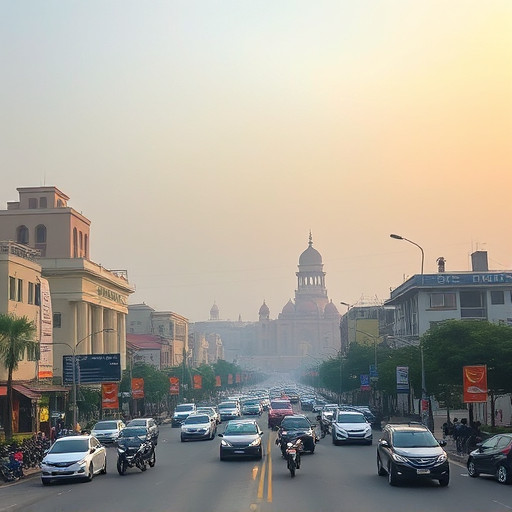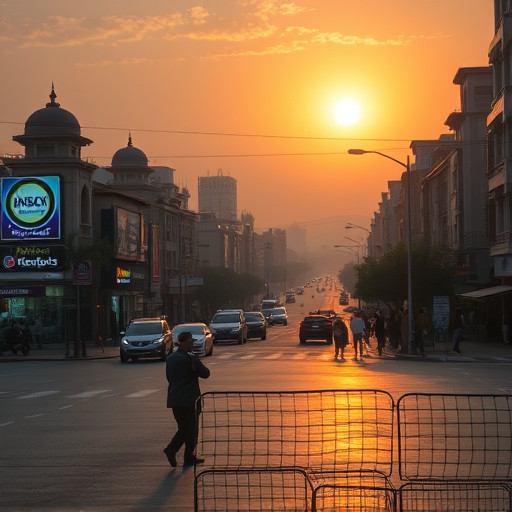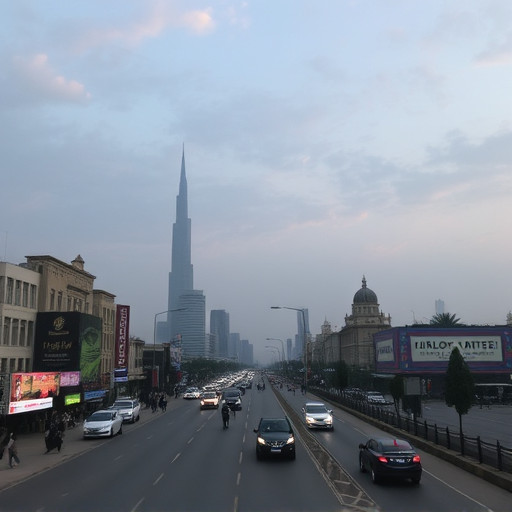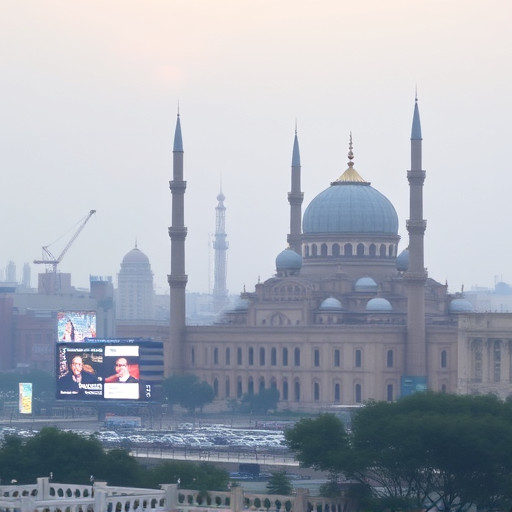Karachi, Pakistan's economic center, faces dramatic changes in rainfall patterns due to climate change, leading to flash floods, water scarcity, and environmental challenges. The city experiences intense monsoon rains (600-800 mm average annually), straining drainage systems and exacerbating urban problems. Residents, authorities, and NGOs demonstrate resilience and unity by evacuating residents, providing relief, and advocating for sustainable practices like green infrastructure to mitigate future disasters.
Karachi, Pakistan’s bustling metropolis, has been experiencing dynamic weather patterns, with rainfall intensifying in recent years. This article delves into five critical updates regarding Karachi’s rain news live, offering a comprehensive overview of the city’s evolving climate. From revealing rainfall trends to assessing environmental impacts and community responses, we explore flash floods, drainage systems, air quality, water levels, traffic disruptions, and relief efforts, providing insights into how Karachi is adapting to its changing weather landscape.
- Karachi's Rainfall Patterns: Recent Trends Revealed
- Live Updates: Flash Floods and Drainage Systems
- Environmental Impact: Air Quality and Water Levels
- Traffic Disruptions and Commute Challenges
- Community Resilience and Relief Efforts
Karachi's Rainfall Patterns: Recent Trends Revealed

Karachi, Pakistan’s economic hub, has experienced notable shifts in rainfall patterns over recent years. Historically known for its arid climate, the city is now witnessing more frequent and intense rainfall events due to climate change and other environmental factors. Data from local meteorology departments shows that Karachi receives an average of 600-800 mm of rain annually, with most of it arriving during the monsoon seasons. However, these patterns have become increasingly unpredictable.
Recent trends reveal a rise in the frequency of heavy downpours, often leading to flash floods and related disasters. In contrast, some years witness prolonged dry spells, exacerbating water scarcity issues. These variable rainfall patterns pose significant challenges for urban planning, infrastructure management, and agriculture in the region. The variability also underscores the urgent need for effective stormwater management strategies to mitigate flooding risks and adapt to changing climatic conditions.
Furthermore, scientists attribute these changes to global warming and regional climate dynamics, emphasizing the need for sustainable practices and policies to safeguard Karachi’s water resources and the well-being of its residents. Understanding and addressing these rainfall trends are crucial steps toward building a resilient and sustainable future for Pakistan’s most populous city.
Live Updates: Flash Floods and Drainage Systems

Karachi, Pakistan’s economic powerhouse, has been grappling with severe flash floods in recent days, causing widespread disruption and concern among residents. Live updates from Karachi Rain News provide a critical snapshot of the situation, particularly regarding drainage systems and their role in mitigating these natural disasters. The city’s drainage infrastructure, often under strain during monsoon seasons, is being closely monitored as water levels rise and overflow into residential areas.
Citizens are taking to social media to share real-time footage of flooded streets and the challenges faced by emergency services in navigating the heavily inundated regions. The updates highlight the need for improved urban planning and infrastructure development to better handle heavy rainfall. Local authorities, aided by volunteer groups, are working tirelessly to evacuate residents, provide relief supplies, and assess damage to critical facilities like hospitals and schools.
Live coverage also directs attention to the long-term solutions being proposed to address Karachi’s drainage woes. Engineers and urban planners are examining innovative strategies to enhance water flow management, including the implementation of green infrastructure and modern waste management systems. These updates serve as a call to action for both citizens and government bodies to collaborate on sustainable practices that can safeguard Karachi against future flash floods.
Environmental Impact: Air Quality and Water Levels

Karachi’s rainfall has significant environmental implications, particularly regarding air quality and water levels. After heavy downpours, the city often experiences a temporary improvement in air quality due to reduced dust and pollution particles suspended in the atmosphere. This can be a breath of fresh air for residents, especially those with respiratory issues. However, prolonged rainfall can also lead to waterlogging and flooding, causing air quality to deteriorate again as stagnant water becomes a breeding ground for mosquitoes and other vectors of disease.
The impact extends beyond immediate health concerns. Increased rainfall can disrupt the delicate balance of local ecosystems, affecting biodiversity and habitat stability. Water bodies, such as rivers and coastal areas, experience fluctuations in flow, which can have cascading effects on aquatic life and the overall health of these ecosystems. Moreover, excessive water ingress into urban areas can contaminate groundwater sources, exacerbating existing environmental challenges.
Karachi’s infrastructure, not designed to handle heavy rainfall, often struggles to cope with the aftermath. This includes strain on drainage systems, leading to frequent flooding in low-lying areas. Managing these issues requires a multi-faceted approach, combining improved urban planning, robust infrastructure development, and effective waste management strategies to mitigate the environmental impact of Karachi’s changing weather patterns.
Traffic Disruptions and Commute Challenges

Karachi’s rainy season often brings about significant traffic disruptions and commute challenges for its residents. Heavy rainfall can lead to flooded roads, causing long delays and making navigation difficult. The city’s infrastructure, though designed to manage some level of rain, struggles under persistent downpours, which can result in water logging and reduced visibility. This not only affects the daily commute but also emergency services, as response times may increase during severe weather conditions.
Commuters often find themselves spending extra hours on the road, leading to increased stress and frustration. Public transportation, already crowded, becomes even more packed as people seek shelter from the rain. This can cause discomfort and sometimes even lead to safety concerns within vehicles stuck in traffic. Additionally, construction sites and ongoing road projects are further hindered by rainfall, potentially causing delays in much-needed infrastructure development.
Despite these challenges, Karachi’s residents have shown resilience over the years, adopting various strategies to cope with the rainy season. From checking real-time traffic updates to choosing alternative routes or modes of transport, people have learned to navigate these disruptions. Local authorities also play a crucial role by providing information about flood-prone areas and offering guidance on safe commuting practices during heavy rainfall.
Community Resilience and Relief Efforts

In the face of intense rainfall and potential flooding, Karachi’s community spirit has shone through with remarkable resilience and relief efforts. Local residents have been quick to organize and support one another, demonstrating a strong sense of unity in the face of adversity. Neighborhoods have come together to clear drainage channels, ensuring water can flow freely and preventing widespread inundation. This collective action not only aids in immediate flood control but also showcases the community’s ability to adapt and recover quickly.
The relief efforts extend beyond individual neighborhoods, with various NGOs and volunteers actively participating in rescue operations and distributing essential supplies like food, medicine, and blankets to affected areas. These organizations have been instrumental in providing critical assistance to families displaced by the rains, setting up temporary shelters, and offering medical aid where needed. The collaborative nature of these initiatives ensures a more comprehensive response, catering to the diverse requirements of Karachi’s diverse population.
Furthermore, community leaders and local businesses have played a pivotal role in coordinating relief efforts, ensuring resources reach those most affected efficiently. This coordinated approach has fostered a sense of security and hope among residents, demonstrating that even intense rainfall cannot overwhelm the spirit of resilience and solidarity within Karachi’s communities.
In light of these crucial updates, Karachi’s recent rainfall events have significantly impacted the city’s infrastructure, environment, and daily life. From changing weather patterns to flash floods and relief efforts showcasing community resilience, each aspect demands attention and adaptation. As the city navigates these challenges, continuous updates and proactive measures are essential to ensure a safer and more sustainable future for all Karachians.

